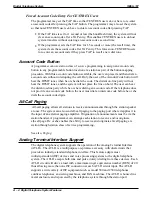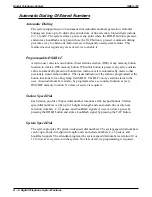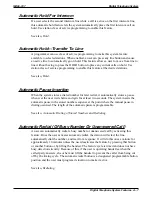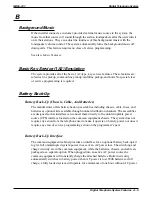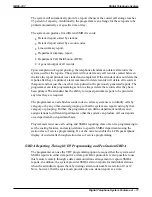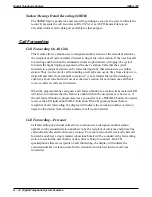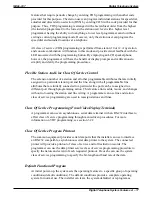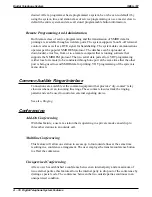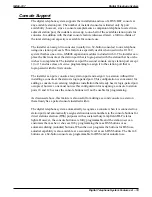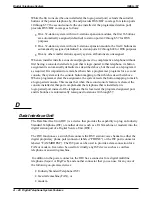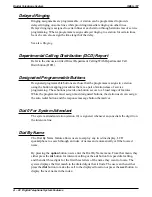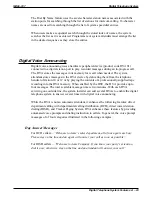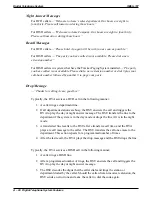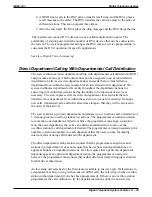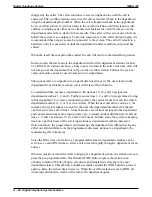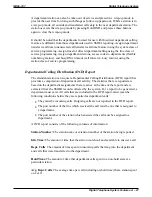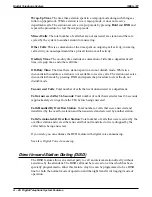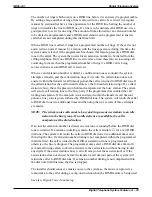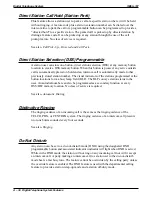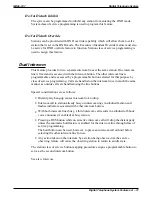
features that require periodic change by entering COS programming with another code
provided for this purpose. The station user can program individual stations for speed dial,
autodial and direct station selection (DSS) by entering COS with a code provided for that
purpose. Thus, COS programming is arranged with a hierarchical order from the highest
(the installer/programmer) to the lowest (the station user) level with a higher level
programmer having the ability to do anything a lower level programmer can do without
exiting a current programming mode. However, only the station user can program the
speed dial and autodial locations at a telephone.
All class of service (COS) programming is performed from station 10 or 12. Any station
and console combination will function in this mode and provide visual feedback with the
LED associated with the programming button. By employing an LCD speakerphone,
however, the programmer will have the benefit of display prompts and verifications to
simplify and clarify the programming procedures.
Flexible Station And Line Class Of Service Control
The extension number of a station and all other programmable attributes that are initially
assigned to a particular station port and the line, along with all programmable line
attributes that are initially connected to a particular line port can be re-assigned to a
different port through programming action. This feature allows adds, moves, and changes
without re-locating the station and line wiring. A programmer can use line and station
class of service programming are used to reassign stations and lines.
Class Of Service Programming (From Video Display Terminal)
A programmer can use an asynchronous, serial data terminal with an RS-232 interface to
effect class of service programming through menu-driven procedures. For more
information on VDT programming, see section 3.2.2
Class Of Service Program Printout
The common equipment provides serial data ports that the installer can use to interface
an RS-232 compatible, asynchronous serial data printer to the system. The connected
printer will provide a printout of class of service and toll restriction records. The
programmer can use the data printer service class of service programming procedure to
specify the nature and extent of each requested printout. He or she can use the system
class of service programming to specify the bit-length and baud rate of the data.
Default Functional Program
At initial power-up, the system sets the operating features to a specific group of operating
conditions (default conditions). The default conditions provide a complete operating
system for normal use. The installer can leave the system defaulted or reprogram as
IMI66–107
Digital Telephone System
Digital Telephone System Features A – 17
Summary of Contents for Air Impact DSU
Page 2: ...Printed in U S A GCA47 157 ...
Page 30: ......
Page 112: ......
Page 192: ...Digital Telephone System IMI66 107 3 80 System Programming ...
Page 283: ......
Page 284: ......
Page 285: ......
Page 286: ......
Page 287: ......
Page 288: ......
Page 289: ......
Page 290: ......
Page 291: ......
Page 292: ......
Page 293: ......
Page 294: ......
Page 295: ......
Page 296: ......
Page 297: ......
Page 298: ......
Page 299: ......
Page 300: ......
Page 301: ......
Page 302: ......
Page 303: ......
Page 304: ......
Page 305: ......
Page 306: ......
Page 307: ......
Page 308: ......
Page 309: ......
Page 310: ......
Page 311: ......
Page 312: ......
Page 313: ......
Page 314: ......
Page 315: ......
Page 316: ......
Page 317: ......
Page 318: ......
Page 319: ......
Page 320: ......
Page 321: ......
Page 322: ......
Page 323: ......
Page 324: ......
Page 325: ......
Page 326: ......
Page 327: ......
Page 328: ......
Page 329: ......
Page 330: ......
Page 331: ......
Page 332: ......
Page 333: ......
Page 334: ......
Page 335: ......
Page 336: ......
Page 337: ......
Page 338: ......
Page 339: ......
Page 340: ......
Page 431: ......
Page 436: ......
Page 437: ......
Page 438: ......


